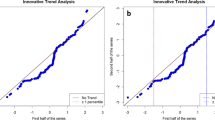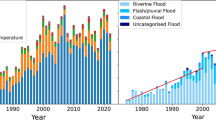Abstract
The Standardized Precipitation Index (SPI) is a worldwide used probability-based drought index. Considering that the two-parameter gamma distribution (gam) is often used to calculate this index, the quality of the fit of this distribution to rainfall series is a key-factor for its performance. Based on the concept of homogeneous regions, the regional frequency analysis (RFA) improves the probabilistic assessment of a variable because it increases the amount of data available for the fitting process. Despite its potential to improve the probabilistic assessment of rainfall data, there is no study verifying if the RFA improves the performance of SPI estimates for describing drought events. Therefore, the goal of this study was to verify whether the RFA can be applied to gam-distributed series, and how this regionalization technique affects the ability of the SPI algorithm to produce normally distributed estimates. This study was based on Monte Carlo experiments, which simulated homogeneous and heterogeneous groups of rainfall series. A normally test specifically designed to assess the normality of SPI frequency distributions was also used. A case study in which the RFA were used to calculate the SPI in the State of São Paulo—Brazil was also carried out. The results indicated that the RFA can be applied to groups of series formed by gam-distributed series. Both Kappa and Wakeby distribution may be used in the RFA calculation algorithm, with the Kappa distribution leading to slightly better results. The RFA improved the ability of the SPI algorithm to produce normally distributed estimates in regional terms.











Similar content being viewed by others
Data availability
The free-license software R was used in this study. The rainfall data belongs to the Agronomic Institute (a public research institute) and they are available at http://clima.iac.sp.gov.br.
Code availability
The fundamental steps of the new method proposed in this study are described in the R-code presented in Table S1.
References
Abramowitz M, Stegun IA (1965) Handbook of mathematical functions with formulas, graphs, and mathematical tables. Dover Publications, New York
Basu B, Srinivas VV (2013) Formulation of a mathematical approach to regional frequency analysis. Water Resour Res 49:6810–6833. https://doi.org/10.1002/wrcr.20540
Ben-gai T, Bittan A, Manes A, Alpert P, Rubin S (1998) Spatial and temporal changes in rainfall frequency distribution patterns in Israel. Theoret Appl Climatol 61:177–190
Blain GC (2012a) Revisiting the probabilistic definition of drought: strengths, limitations and an agrometeorological adaptation. Bragantia 71:132–141. https://doi.org/10.1590/S0006-87052012000100019
Blain GC (2012b) Monthly values of the Standardized Precipitation Index in the State of São Paulo, Brazil: trends and spectral features under the normality assumption. Bragantia 71:122–131. https://doi.org/10.1590/S0006-87052012005000004
Blain GC, De Avila AMH, Pereira VR (2018) Using the normality assumption to calculate probability based standardized drought indices: Selection criteria with emphases on typical events. International Journal of Climatology. https://doi.org/10.1002/joc.5381
Blain GC and Meschiatti MC (2014) Using multi-parameters distributions to assess the probability of occurrence of extreme rainfall data. Rev Bras Eng Agríc Ambient 18 (3). https://doi.org/10.1590/S1415-43662014000300010
Blain GC, Sobierajski GR, Xavier ACF, de Carvalho JP (2021) Regional frequency analysis applied to extreme rainfall events: evaluating its conceptual assumptions and constructing null distributions. Annals of the Brazilian Academy of Sciences 93:1. https://doi.org/10.1590/0001-3765202120190406
Blain GC, Sobierajski GR, Weight E, Martins LL, Xavier ACF (2022) Improving the interpretation of standardized precipitation index estimates to capture drought characteristics in changing climate conditions. Int J Climatol (online version). https://doi.org/10.1002/joc.7550
Bradley AA (1998) Regional frequency analysis methods for evaluating changes in hydrologic extremes. Water Resour Res 34: 741–750. https://agupubs.onlinelibrary.wiley.com/doi/pdf/10.1029/98WR00096
Castellarin A, Burn D, Brath A (2008) Homogeneity testing: how homogeneous do heterogeneous cross-correlated regions seem? J Hydrol 360:67–76. https://doi.org/10.1016/j.jhydrol.2008.07.014
Fowler HJ, Kilsby CG (2003) A regional frequency analysis of United Kingdom extreme rainfall from 1961 to 2000. Int J Climatol 23:1313–1334. https://doi.org/10.1002/joc.943
Goudenhoofdt E, Delobbe L, Willems P (2017) Regional frequency analysis of extreme rainfall in Belgium based on radar estimates. Hydrol Earth Syst Sci 21:5385–5399. https://doi.org/10.5194/hess-21-5385-2017
Guttman GB (1998) Comparing the Palmer Drought Index and the “Standardized Precipitation Index.” J Am Water Resour 16:113–121. https://doi.org/10.1111/j.1752-1688.1998.tb05964.x
Guttman GB (1999) Accepting the “Standardized Precipitation Index”: a calculation algorithm index. J Am Water Resour 35:311–322
Hao Z, Yuan X, Xia Y, Hao F, Singh VP (2017) An overview of drought monitoring and prediction systems at regional and global scales. Bull Am Meteorol Soc 98:1879–1896. https://doi.org/10.1175/BAMS-D-15-00149.1
Hayes MJ, Svoboda MD, Wall N, Widhalm M (2011) The Lincoln declaration on drought indices - universal meteorological drought index recommended. Bull Am Meteor Soc 92(4):485–488. https://doi.org/10.1175/2010BAMS3103.1
Hosking JRM, Wallis JR (1997) Regional frequency analysis: an approach based on L-moments. Cambridge University Press. https://doi.org/10.1017/cbo9780511529443
Khaliq MN, Ouarda TBMJ (2007) On the critical values of the standard normal homogeneity test (SNHT). Int J Climatol 27(5):681–687. https://doi.org/10.1002/joc.1438
Kjeldsen TR, Prosdocimi I (2015) A bivariate extension of the Hosking and Wallis goodness-of-fit measure for regional distributions. Water Resour Res 51:896–907. https://doi.org/10.1002/2014WR015912
Lloyd-Hughes B, Saunders MA (2002) A drought climatology for Europe. Int J Climatol 22(13):1571–1592. https://doi.org/10.1002/joc.846
McKee TB, Doesken NJ, Kleist J (1993) The relationship of drought frequency and duration to the time scales. In Proceedings of the 8th Conference on Applied Climatology; Anaheim, USA
Neykov NM, Neytchev PN, Van Gelder PHAJM, Todorov VK (2007) Robust detection of discordant sites in regional frequency analysis. Water Resour Res 43(6):W06417. https://doi.org/10.1029/2006WR005322
Odewale O, Adebola A (2019) Integration of Standardized Precipitation Index and Drought Severity Index for assessment of drought in the Sudano-Sahelian ecological zone of Nigeria. Clim Chang 5:188–199. https://doi.org/10.1080/19376812.2020.1841658
Pereira VR, Blain GC, Avila AMH, Pires RCM, Pinto HS (2018) Impacts of climate change on drought: changes to drier conditions at the beginning of the crop growing season in southern Brazil. Bragantia 77(1):201–211. https://doi.org/10.1590/1678-4499.2017007
Pieper P, Düsterhus A, Baehr J (2020) A universal Standardized Precipitation Index candidate distribution function for observations and simulations. Hydrol Earth Syst Sci 24:4541–4565. https://doi.org/10.5194/hess-24-4541-2020
Raia A, Cavalcanti IFA (2008) The life cycle of the South American Monsoon System. J Clim 21(23):6227–6246. https://doi.org/10.1175/2008JCLI2249.1
Requena AI, Chebana F, Mediero L (2016) A complete procedure for multivariate index-flood model application. J Hydrol 535:559–580. https://doi.org/10.1016/j.jhydrol.2016.02.004
Rousseeuw PJ, Leroy AM (1987) Robust regression and outliers detection. John Wiley, United States of America
Nadarajah S, Kotz S (2006) R programs for computing truncated distributions. J Stat Soft 16. Code snippet 2 https://doi.org/10.18637/jss.v016.c02
Santos JF, Portela MM, Pulido-Calvo I (2011) Regional frequency analysis of droughts in Portugal. Water Resour Manage 25:3537–3558. https://doi.org/10.1007/s11269-011-9869-z
Solakova T, Michele C, Vezzoli R (2014) Comparison between parametric and nonparametric approaches for the calculation of two drought indices: SPI and SSI. J Hydrol Eng 19 (9). https://doi.org/10.1061/(ASCE)HE.1943-5584.0000942
Stagge JH, Tallaksen LM, Gudmundsson L, Van Loon AF, Stahl K (2015) Candidate distributions for climatological drought indices (SPI and SPEI). Int J Climatol 35(13):4027–4040. https://doi.org/10.1002/joc.4267
Sung JH, Kim YO, Jeon JJ (2018) Application of distribution-free nonstationary regional frequency analysis based on L-moments. Theoret Appl Climatol 133:219–1233. https://doi.org/10.1007/s00704-017-2249-8
Svensson C, Jones DA (2010) Review of rainfall frequency estimation methods. J Flood Risk Manag 3:296–313. https://doi.org/10.1111/j.1753-318X.2010.01079.x
Vera C, Higginis W, Amador JA, Ambrizzi T, Garreauld D, Gochis D, Gutzler D, Lettenmaier D, Marengo J, Mechoso CR, Nouges-Paeagle J, Silva-Dias PL, Zhang C (2006) Toward a unified view of the American monsoon systems. J Clim 19(20):4977–5000. https://doi.org/10.1175/JCLI3896.1
Vicente-Serrano SM, Beguería S, López-Moreno JI (2010) A multiscalar drought index sensitive to global warming: the standardized precipitation evapotranspiration index. J Clim 23(7):1696–1718. https://doi.org/10.1175/2009JCLI2909.1
Wu H, Svoboda MD, Hayes MJ, Wilhite DA, Wen F (2007) Appropriate application of the Standardized Precipitation Index in arid locations and dry seasons. Int J Climatol 27:65–79. https://doi.org/10.1002/joc.1371
Yang P, Xia J, Zhan C, Zhang Y, Hu S (2018) Discrete wavelet transform-based investigation into the variability of Standardized Precipitation Index in Northwest China during 1960–2014. Theor Appl Clim 132:167–180. https://doi.org/10.1007/s00704-017-2063-3
Zhang Q, Xu CY, Zhang ZX (2009) Observed changes of drought/wetness episodes in the Pearl River basin, China, using the Standardized Precipitation Index and Aridity Index. Theor Appl Clim 98:89–99. https://doi.org/10.1007/s00704-008-0095-4
Zuo DD, Hou W, Zhang Q, Yan PC, (2021) Sensitivity analysis of standardized precipitation index to climate state selection in China. Adv Clim Change Res 13(1):42–50. https://doi.org/10.1016/j.accre.2021.11.004
Acknowledgements
To CNPq for Fellowship for the first author (Process 307616/2019-3).
Funding
CNPq (fellowship for the fourth author—Process 307616/2019–3) and CAPES (scholarship for the first and third authors).
Author information
Authors and Affiliations
Contributions
Conceptualization: Blain G.C. and Sobierajski G.R.; methodology: Blain G.C. and Sobierajski G.R.; investigation: Blain G.C., Sobierajski G.R., Xavier, A.C.F., Martins L.L., Santos Júnior E. P.; writing—original draft: Blain G.C. and Sobierajski G.R.; writing—review and editing: Blain G.C., Sobierajski G.R., Xavier, A.C.F., Martins L.L., Santos Júnior E. P.; supervision: Blain G.C.
Corresponding author
Ethics declarations
Conflict of interest
The authors declare no competing interests.
Additional information
Publisher's note
Springer Nature remains neutral with regard to jurisdictional claims in published maps and institutional affiliations.
Rights and permissions
About this article
Cite this article
dos Santos Junior, E.P., Xavier, A.C.F., Martins, L.L. et al. Using a regional frequency analysis approach for calculating the Standardized Precipitation Index: an operational approach based on the two-parameter gamma distribution. Theor Appl Climatol 148, 1199–1216 (2022). https://doi.org/10.1007/s00704-022-03989-7
Received:
Accepted:
Published:
Issue Date:
DOI: https://doi.org/10.1007/s00704-022-03989-7






